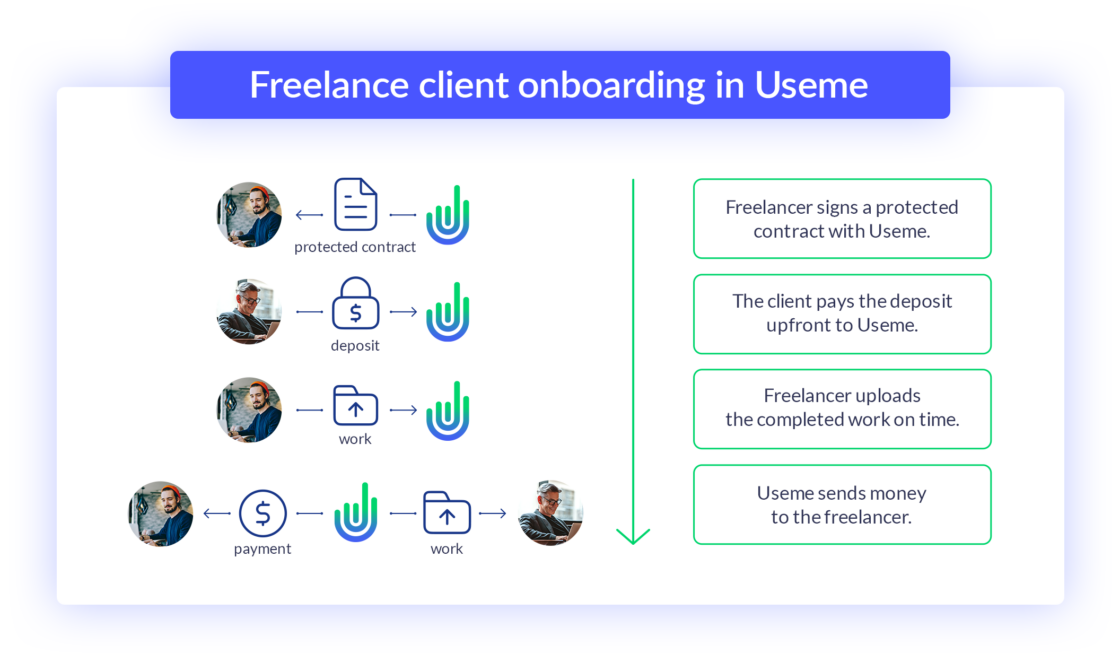Can you imagine jumping into math problems in a new chapter of your student book without learning formulas first? You would raise your hand and look pleadingly at the teacher with every exercise!
The same goes for successful collaboration with new clients. You can’t effectively perform your freelance gigs without learning your client’s needs, expectations, concerns, and hopes. That’s what the good client onboarding process is for.
What is client onboarding? We’ve described the crucial stages of the customer onboarding process for freelancers. Read our article or scroll down for the meat to our freelance client onboarding checklist. You can use it every time a new client comes up. Grow your freelance business with our automation hacks!
What is the client onboarding process?
Client onboarding (or customer onboarding) is the official “welcome aboard!” moment in your freelance journey with a new client. The customer onboarding process is the crucial phase that begins the moment you agree to work together and ends when you’re fully prepped to dive into the project.
Customer onboarding lets your clients know you value their business and sets the stage for success. The client onboarding process covers all the nitty-gritty details like communication preferences, your working style, feedback methods, and clear expectations from both sides.
Why is client onboarding important? Here’s why it’s crucial for your freelance career and long-lasting client relationships:
- It builds a rock-solid foundation – the client onboarding process establishes a clear path for your future relationship, fostering trust along the way.
- It prevents misunderstandings – it sets expectations and boundaries, minimizing frustrations later.
- It confirms professionalism – a good onboarding process shows you know and organize your freelance game perfectly (even if you’re secretly winging it a little.)
- It saves your time – onboarding streamlines project workflow, cutting down on unnecessary back-and-forth.
- It minimizes freelance pitfalls – it helps you avoid scope creep, mismatched expectations, and endless administrative hassles.
In short, an effective onboarding process makes you and your client a happy, productive team.

Freelance client onboarding process
Check our client onboarding best practices to prepare a well-structured onboarding process and build a positive client experience. Even if you work as a solopreneur and own all the tasks, it’s worth introducing some project management and streamlining onboarding. When you gain new clients, you’ll have an excellent onboarding strategy in place and avoid inventing it from scratch.
New client onboarding process: Preliminary arrangements
Before the work begins, you need to gather some intel. Start by preparing a list of questions to uncover everything you need to know about the project and the client’s expectations. Don’t hesitate to dig deep – clarity now means success later.
Organize a client onboarding meeting. Schedule a discovery call, send an intro email, or use other communication method to get the ball rolling. These questions aren’t just about the work itself; they’re your chance to gauge whether this is a client you truly want to work with. Things don’t feel right? Be honest with yourself, as a mismatch now saves headaches for everyone in the long run. Strive for mutual understanding.
Focus on these key areas during your initial customer onboarding discussions:
- Scope, goals, and deliverables: What’s the big picture, and exactly what will you provide?
- Timeframe: What are realistic deadlines? Is there flexibility if the project evolves?
- Payment schedule: When and how will you be compensated?
- Required materials: Does the client have assets you’ll need, or is sourcing part of your job?
After that initial exchange, summarize all the agreed-upon details in a clear and professional document. Once new customers accept it, send them a follow-up client questionnaire to delve even deeper into their needs and the project’s nuances.
Pro-Tip: The customer onboarding process isn’t just about gathering info; it’s an opportunity to showcase your value. Could you offer additional services to enhance the project’s outcome? Don’t be pushy, but present compelling arguments linked to your client’s business growth. They might not even realize what they’re missing until you show them.
Client onboarding questionnaire: further investigation
A well-crafted questionnaire brings your client’s perspective on the project. It’s important to avoid asking about information you’ve already covered in earlier conversations. Your goal is to gain new insights, not make your clients repeat themselves.
Here are some powerful questions to include in your questionnaire for every new client:
- What is the target audience of the copy/design/website/translation, etc.?
- Who is your primary competition?
- How did you find me, and why did you choose me for this freelance project?
- What are your expectations regarding our collaboration?
- Are there any past mistakes you want to avoid?
- Are there brands, styles, or other sources of inspiration that resonate with you?
- Do you have specific tools, programs, or websites I need to access?
- What are your preferred methods for updates, feedback, and ongoing communication? How often should we check in?
- Can I mention our collaboration and project deliverables in my portfolio?
To streamline the customer onboarding process and raise client satisfaction, create a questionnaire template, e.g., in a Google Doc. You can customize it for each client, adding or removing questions as needed. This keeps you organized and ensures you’re hitting all the essential points for a smooth, successful collaboration.
Contract: Sealing the deal and setting expectations
After the initial onboarding stages, it’s time to make things official with a contract. This document is your safety net, ensuring both you and your client are on the same page about the project’s terms. If you’re drafting your own contract, here are the essentials to include:
- contact details,
- responsibilities on both sides,
- project outline (goals, scope, deliverables, and timeline),
- deadlines (key milestones and payment dates),
- confidentiality (non-disclosure agreement if needed),
- copyright transfer,
- price and payment,
- point of contact.
Consider working with a third-party platform or service that specializes in freelancer protection. Platforms such as Useme provide standardized contracts, payment escrow, and even dispute resolution services. It offers an extra layer of security for freelancers and can give both you and your client peace of mind.
When you sign a secure contract via Useme, your customer onboarding process is supported by double-edged protection: Your client pays the deposit, and you upload your work. You’ll get paid once you upload your work, and your client will get your work once they pay the deposit. That’s a fair win-win!

Organization check for flawless client onboarding experience
Once you know all the expectations and requirements of your client, send them the nuts and bolts of your collaboration compiled in one document. Such a “welcome pack” with all the organizational matters will make for a rewarding customer onboarding experience.
Here’s what to include:
- Project roadmap: Split the project into clear phases, milestones, and deadlines. Highlight feedback and follow-up meeting dates along the way.
- Communication: Specify the tools you’ll use for day-to-day communication (Slack, Teams, email, etc.), periodic client feedback (e.g., Google Meet), and comments on the project (e.g., Google Docs comments, Figma annotations, etc.). Set details for your response times.
- Feedback and revision flow: Will your client provide ongoing feedback or only at specific stages? Establish a schedule and process that aligns with both your working styles. Some clients prefer frequent updates, while others want to leave it till the end.
- Payment terms: Reinforce the agreed-upon payment schedule, and remember to outline any late fee policies. For more money-centered advice, check our article about financial wellness tips for freelancers.
Pro-Tip: Don’t underestimate the power of design. A well-formatted, visually appealing welcome pack sets the tone for a professional and positive working relationship. Think of the customer onboarding process as the first sign of the experience you plan to deliver.
Materials and final acceptance
With a solid understanding of your client’s needs and your own capabilities, prepare the materials you’ll send them.
Whether it’s mood boards bursting with inspiration for a design project, technical specs for a development task, or a style guide for a translation, this is your chance to visually or textually represent the project direction. Thoroughly explain your choices and seek your client’s approval or feedback.
This step is about collaboration, not just compliance. Actively engage your client, provide clear explanations, and welcome their input. Secure a solid foundation of shared understanding.
Refine your freelance client onboarding
Your client onboarding process should evolve. With every new project, pay close attention to what works well and where there’s room for improvement.
Do you find yourself asking the same questions mid-project that should have been covered upfront? Add them to your onboarding checklist. Track the time you spend onboarding and cut out any unnecessary steps or repetitive questions. Your goal is efficiency, not bureaucracy – you want to impress new customers with your swiftness and focus.
As you gain experience, you may notice that different types of new clients or projects require slightly adjusted onboarding approaches. A copywriter, for example, might need tailored onboarding for different industries or for clients ordering blog posts versus social media copy. Create a few specialized client onboarding processes to streamline your work and ensure you’re gathering the essential information for each unique scenario.
Remember, a well-designed onboarding process isn’t a one-and-done deal. You should continuously refine over time, saving you headaches, boosting your efficiency, and growing your freelance business!
Freelance client onboarding checklist
Client onboarding best practices in a nutshell? We’ve got you covered! Download our to-do list for freelancers who want to reassuringly welcome their clients on board. Follow these steps, or adjust it to your working style and create your own onboarding process.
Automating your client onboarding process with a checklist saves you time and energy, allowing you to focus on your tasks. If you want to introduce more automation hacks and level up your freelance workflow, check our email templates.




